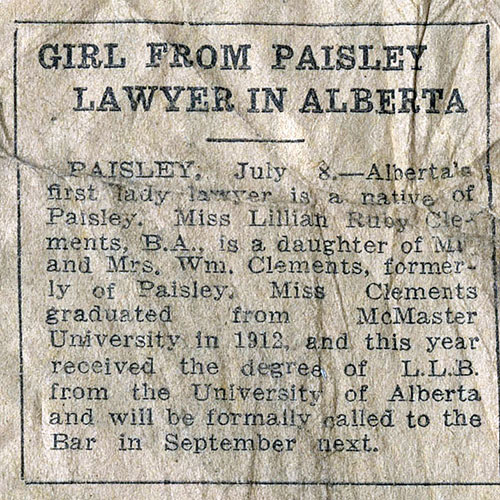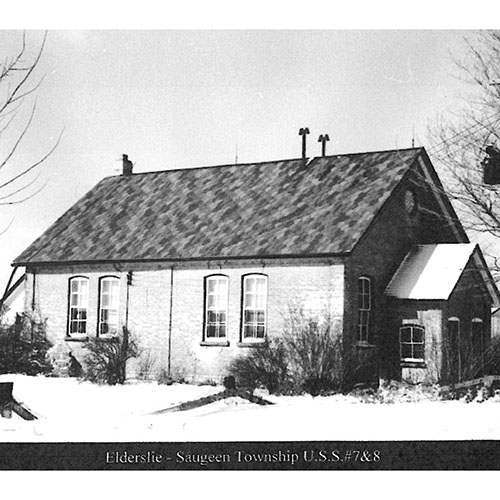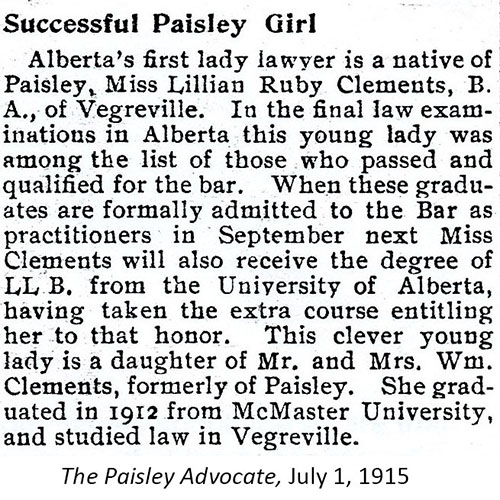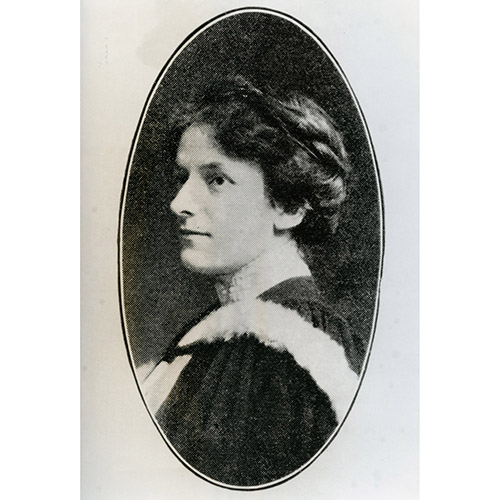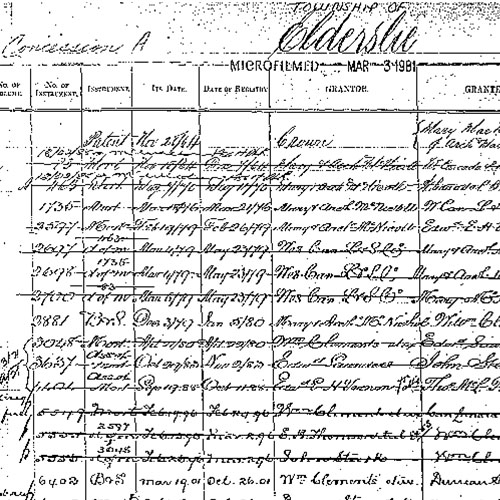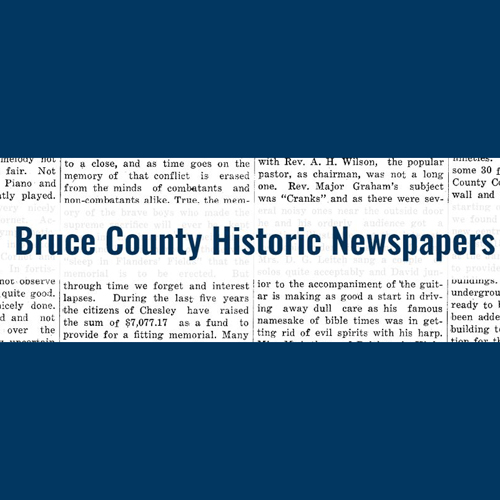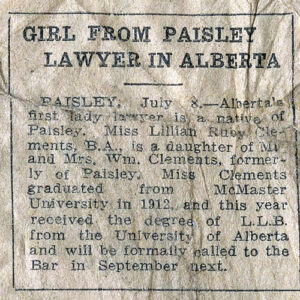 A small July 9, 1915 “London Advertiser” newspaper clipping with headline “Girl from Paisley Lawyer in Alberta” proclaims that former Paisley-area resident Lillian Ruby Clements had become the first “lady lawyer” in Alberta. The article indicates that she was the daughter of William Clements; she graduated from McMaster University in 1912; received her LLB degree from University of Alberta in 1915; and was to be called to the Alberta Bar in September 1915. This inspired curiosity about Lillian’s life in Bruce County. It’s interesting to imagine what influences and support this young person may have experienced in Bruce County during her formative years, eventually leading her to become a trailblazer for women in the legal field!
A small July 9, 1915 “London Advertiser” newspaper clipping with headline “Girl from Paisley Lawyer in Alberta” proclaims that former Paisley-area resident Lillian Ruby Clements had become the first “lady lawyer” in Alberta. The article indicates that she was the daughter of William Clements; she graduated from McMaster University in 1912; received her LLB degree from University of Alberta in 1915; and was to be called to the Alberta Bar in September 1915. This inspired curiosity about Lillian’s life in Bruce County. It’s interesting to imagine what influences and support this young person may have experienced in Bruce County during her formative years, eventually leading her to become a trailblazer for women in the legal field!
Life on the Farm
Lillian Ruby Clements was born in 1886 and was the second youngest of five children born to farmer William J. Clement(s) of Elderslie Township and Louisa “Lucy” Chisholm of Culross Township. The family resided in Elderslie Township in a 1.5 storey wood house with four rooms. (Lillian Ruby appears to have been known as Lilly, Ruby, and Lillian at various times throughout her life).
The 1892 tax assessment rolls, 1895 Bruce County directory, and Ontario land records reveal that Lillian Ruby grew up on a mixed farm in Elderslie Township on Concession A, Lots 24 and 25, a property situated on Bruce Road 3, just north of Paisley, Ontario. By 1892, 80 acres had been cleared for farming on each of the two lots, which also housed 40 cattle, 22 sheep, 1 hog, and 6 horses. The family maintained three acres of orchard/garden, and 18 acres of fall wheat. Lillian Ruby’s father sold the property through a Deed signed in March 1901.
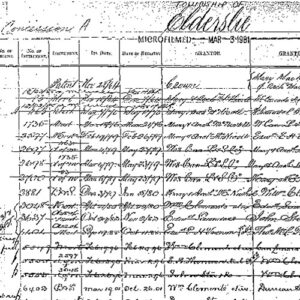
Schooling in Bruce County
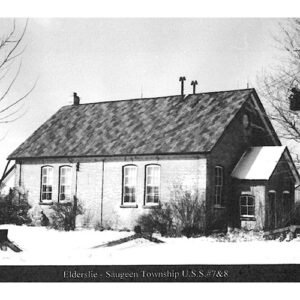 Lillian Ruby attended the rural school known as S.S. No. 7 (School Section 7) in Elderslie Township, Bruce County, Ontario, which later became known as Saugeen-Elderslie Township United School Section No. 7 & 8, located on Highway 3 (a.k.a. Elora Road), north of Paisley very close to the Clements farm. The School Board has deposited its historic school attendance registers at the BCM&CC; unfortunately, the register for this school during the 1890s time period is not among the collection. Nor do we currently have any class photographs from that time period. This is a photograph of the U.S.S. No. 7 & 8 schoolhouse, taken from the Bruce County Genealogical Society’s “Schools” binders located in our Research Room.
Lillian Ruby attended the rural school known as S.S. No. 7 (School Section 7) in Elderslie Township, Bruce County, Ontario, which later became known as Saugeen-Elderslie Township United School Section No. 7 & 8, located on Highway 3 (a.k.a. Elora Road), north of Paisley very close to the Clements farm. The School Board has deposited its historic school attendance registers at the BCM&CC; unfortunately, the register for this school during the 1890s time period is not among the collection. Nor do we currently have any class photographs from that time period. This is a photograph of the U.S.S. No. 7 & 8 schoolhouse, taken from the Bruce County Genealogical Society’s “Schools” binders located in our Research Room.
Lillian Ruby was 15 years old in 1901 when her family’s farm property was sold, an age at which she could have been attending high school if one was available in her area. The village of Paisley had made several requests to County Council requesting designation as a High School District in 1872, 1887, and 1891, but either never received the necessary consent or would not agree to an increase in taxation in exchange for the service. How could a young girl ever consider entering the legal profession without access to a High School education? The comments of the editor of The Paisley Advocate in 1895 demonstrate a passion for secondary education: “Nothing is plainer than that a high school placed in Paisley would be situated in the very heart of the best educational constituency in the county. Towards the accomplishment of this object, viz; the establishment of one here, the energies of the people should be persistently directed.” Despite lacking designation as a High School District, Paisley still provided a higher level of education. In 1897 it opened a Continuation School, within the public school building, with Principal W.I. Chisholm taking charge without hiring an extra teacher. Forty students enrolled that year (likely for grades 9 and 10). In 1901, a year that Lillian Ruby is believed to have been attending the school, assistant J.W. Bolbrook was hired.
Lillian Ruby’s Parental Influences
A look at Lillian Ruby’s parents and grandparents gives us a glimpse of influences which may have supported her in completing her education beyond the norms at that time. Her father William (son of William and Mary Ann Clements of Elderslie Township) was the third eldest of eight children. By the 1871 census, only one of his siblings, eight-year-old James, was attending school. 13-year old William, his two older and next youngest sisters were not listed as attending school, and may have been working hard on the farm as was the norm at that time. Although William does not appear to have attended school much into his teenage years, he later served as a trustee of the school which his children attended and acted as Trustee Secretary from December 1882 to December 1896.
On her maternal side, Lillian Ruby’s mother, Lucy, who was 16 years old and the oldest of seven children in 1871, was attending school, along with her four siblings aged 6 to 14. Lucy became a teacher. The booklet “Some Sketches of School Section No. 9, Elderslie Township, Bruce County, Ontario” provides some insightful details about Lillian Ruby’s mother: “He [teacher Mr. Harron] engaged Miss Lucy Chisholm of Paisley to finish out the year [when he was compelled to return home in September 1876 due to illness in the family]. … This young woman was the kind of teacher who took her work seriously. She was a very competent business woman and organized her school work effectively. Her methods of discipline were different from those of her predecessor, and she could be firm without losing her temper. The effect on the school was good and the attendance increased, reaching what was, as far as I know, the high water mark for S.S. No. 9. … an attendance of 88 which likely was the maximum. This was a heavy school but she carried it through with satisfaction to all. She was re-engaged for 1877 at a salary of $360, which for a female teacher, at that date, was quite substantial. At the end of this year she resigned, expecting to teach on the Elora Road but … secured the school in No. 11 on the 10th concession.” She continued to teach until 1879 when she married, but one can imagine her continued influence on her children.
Although both of Lillan Ruby’s parents grew up in households identified as Methodist in census documents (in fact a Methodist Church built on Ruby’s paternal grandfather’s farm was named “Clements Methodist Church”), her family listed “Baptist” as their religion in the 1891 census.
The closest Baptist Church to the Clements family farm, which they may have attended, was at 288 Church Street, Paisley, on the banks of the Saugeen River.
Leaving Bruce County
The 1901 census (taken in March of that year) listed Lillian Ruby Clements, identified as “Rubbie”, living in the village of Paisley with her mother and four siblings. A search of the Paisley Advocate newspapers in our Bruce County Historic Newspapers website resulted in the discovery of a couple of articles about the family around that time. Her father William and four other men were in the Klondike for more than a year, looking for gold from February 1898 to July 1899, and had “done fairly well on the trip” (The Paisley Advocate, July 27, 1899). An August 15, 1901 article confirmed the family’s departure from Bruce County: “Mrs. W.J. Clements and family left on Tuesday for Edmonton, where they will reside in future, and where Mr. Clements will join them shortly. The latter is still in the Klondike, but has decided to locate at Edmonton when he has had enough of the gold country. The people of Paisley are sorry to lose Mr. and Mrs. Clements and their interesting young family as fellow citizens.” The adjective “interesting” caught our attention, as a young woman like Lillian Ruby, who would eventually pursue a then male-dominated profession, may have stood out in her community, but further searches of the newspaper to date have not shed any more light on the Clements family children to date. It may be possible to discover more about the family by browsing issues of the Paisley newspaper, as the search function is not 100% accurate due to the software limitations, font and condition of some of the digitized newspapers.
After leaving Bruce County, the family settled first at Strathcona (which later became Edmonton, Alberta) in 1901, before moving to Vegreville, Alberta, where William opened a general store and post office. William was also the first chair of the school board and Vegreville’s first full-time mayor.
Continuing Education
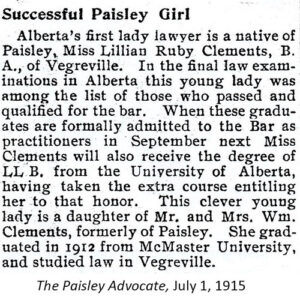 Lillian Ruby graduated from high school in the west and filled the role of organist at the Vegreville Baptist Church for a few years before deciding to continue her education. She returned to Ontario to study economics at McMaster University in Hamilton, where she received her Bachelor of Arts in 1912. In 1913 she was admitted to the University of Alberta as a graduate student with the intent to pursue a career in law. The Law Society approved her application “on the assumption that the Legal Profession Act and the rules of the Society extend to the admission of women. If they do not, no approval granted” (Petersson, 1996). She articled with Frederic Augustus Morrison at the firm of Landry Morrison in Vegreville, Alberta. At that time, the Law Society required three years of articles, attendance at lectures and the passing of three exams offered by the University of Alberta under an agreement with the Law Society (the Faculty of Law wasn’t officially established until 1921). Although she was not the first woman to enroll in legal studies there, she was the first woman to graduate with an LLB from the University of Alberta. In addition to The London Advertiser, The Paisley Advocate announced Ruby’s success in its July 1, 1915 issue.
Lillian Ruby graduated from high school in the west and filled the role of organist at the Vegreville Baptist Church for a few years before deciding to continue her education. She returned to Ontario to study economics at McMaster University in Hamilton, where she received her Bachelor of Arts in 1912. In 1913 she was admitted to the University of Alberta as a graduate student with the intent to pursue a career in law. The Law Society approved her application “on the assumption that the Legal Profession Act and the rules of the Society extend to the admission of women. If they do not, no approval granted” (Petersson, 1996). She articled with Frederic Augustus Morrison at the firm of Landry Morrison in Vegreville, Alberta. At that time, the Law Society required three years of articles, attendance at lectures and the passing of three exams offered by the University of Alberta under an agreement with the Law Society (the Faculty of Law wasn’t officially established until 1921). Although she was not the first woman to enroll in legal studies there, she was the first woman to graduate with an LLB from the University of Alberta. In addition to The London Advertiser, The Paisley Advocate announced Ruby’s success in its July 1, 1915 issue.
Although Alberta was the fourth Canadian province to admit women to the bar, following Ontario, New Brunswick and British Columbia, it was the only province where there was no formal resistance to women becoming lawyers. The Edmonton Journal in July 1915 also reported on Ruby’s accomplishment: “Apparently exponents of the law in Alberta have no fear of any drastic influence when feminine brains are given full swing in the realms of law, for not only is the invasion of womankind allowed by the Law Society, but local barristers when spoken to stated that the personally had no objection to welcoming ‘a petticoat’ to the bar” (Petersson, 1996).
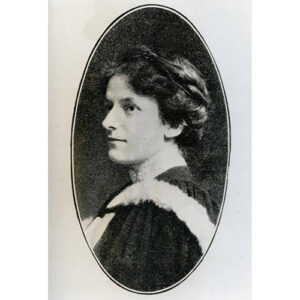 After Lillian Ruby’s admission to the Bar in 1915, women began to study law in Alberta in increasing numbers until the early to mid-1920s when the present model of academic legal education was introduced to replace the professional model, increasing admission standards which diminished its appeal to all genders. According to an article by Sandra Petersson in “Architypes” the Legal Archives Society of Alberta Newsletter (2001), only an average of one woman per year entered Alberta’s legal profession for the 50 years following Ruby’s 1915 admission. The low rate is often explained by social norms that opposed professional employment for woman; in addition, the economic and social disturbance associated with the Depression may have played a role.
After Lillian Ruby’s admission to the Bar in 1915, women began to study law in Alberta in increasing numbers until the early to mid-1920s when the present model of academic legal education was introduced to replace the professional model, increasing admission standards which diminished its appeal to all genders. According to an article by Sandra Petersson in “Architypes” the Legal Archives Society of Alberta Newsletter (2001), only an average of one woman per year entered Alberta’s legal profession for the 50 years following Ruby’s 1915 admission. The low rate is often explained by social norms that opposed professional employment for woman; in addition, the economic and social disturbance associated with the Depression may have played a role.
Although Ruby was admitted to the Bar in 1915, she did not carry on to practise law. A few months after her admission to the bar, she married businessman Chester Dunham Gainer and continued to be an influential member of her community. Her family life centered around the Gainer family meat packing business and South Side Baptist Church were she taught Sunday School. She and Chester raised four children: Herbert Gainer, Dr. Gordon Gainer (who earned a Ph.D. in organic chemistry), Lucy Weeks (an accomplished pianist and piano teacher), and Dr. Walter Gainer (who earned a Ph.D. in Economics). Later in life, Lillian Ruby was the provincial vice-president of the Women’s Christian Temperance Union; vice-president of the Local Council of Women in Edmonton in 1939; president of the Women’s Canadian Club from 1943 to 1945; and the first vice-president of the Women’s Missionary Auxiliary of the Baptist Union of Western Canada in 1943 (Elford, 2019).
Lillian Ruby Clements Gainer passed away in 1956 and is buried in Edmonton, Alberta.
Sources
Elderslie Historical Society. “A History of Elderslie Township 1851-1977.” Chesley: Elderslie Historical Society, 1977. Print.
Elderslie Township Assessment Roll, 1892.
Elford, Brea. “Ruby Clements: Pioneer for Women in Law.” University of Alberta, Faculty of Law, March 8, 2019. https://www.ualberta.ca/law/about/news/2019/3/ruby-clements.html. Accessed November 21, 2022.
“Girl from Paisley Lawyer in Alberta” “The London Advertiser,” July 8, 1915, page 3, BCM&CC A2008.095.001.
“Lillian Ruby Clements Gainer” https://www.findagrave.com/memorial/95716015/lillian-ruby-gainer, accessed December 20, 2022.
Marshall, Duncan. “Some Sketches of School Section No. 9, Elderslie Township, Bruce County, Ontario.” Chesley: The Chesley Enterprise, 1933. Print. BCM&CC A2016.036.001
Paisley Advocate newspapers (as cited in the text), https://newspapers.brucemuseum.ca/
Petersson, Sandra. “Ruby Clements: Welcoming a ‘Petticoat’ to the Alberta Bar.” Architypes: Legal Archives Society of Alberta Newsletter, volume 5, issue 2, Summer 1996.
Petersson, Sandra. “Women Lawyers and Law Students 1915-1935.” Architypes: Legal Archives Society of Alberta Newsletter, volume 10, issue 1, Summer 2001.
S.S. # 7 & 8 School Trustee Records, held by Treasure Chest Museum, Paisley, Ontario.
Saugeen History Hunters. “Roots and Branches of Saugeen, 1854-1984: a history of Saugeen Township.” [Port Elgin, Ont.]: Saugeen History Hunters, 1984. Print. BCM&CC AX2004.0087.
“The Union Publishing Company’s Farmers and Business Directory for the Counties of Bruce, Huron, Middlesex and Perth, 1895.” Union Publishing Company, 1895. Print. BCM&CC A2009.002.050.
“Women Lawyers.” The Legal Archives Society of Alberta, https://legalarchives.ca/project/women-lawyers/. Accessed December 22, 2022.

